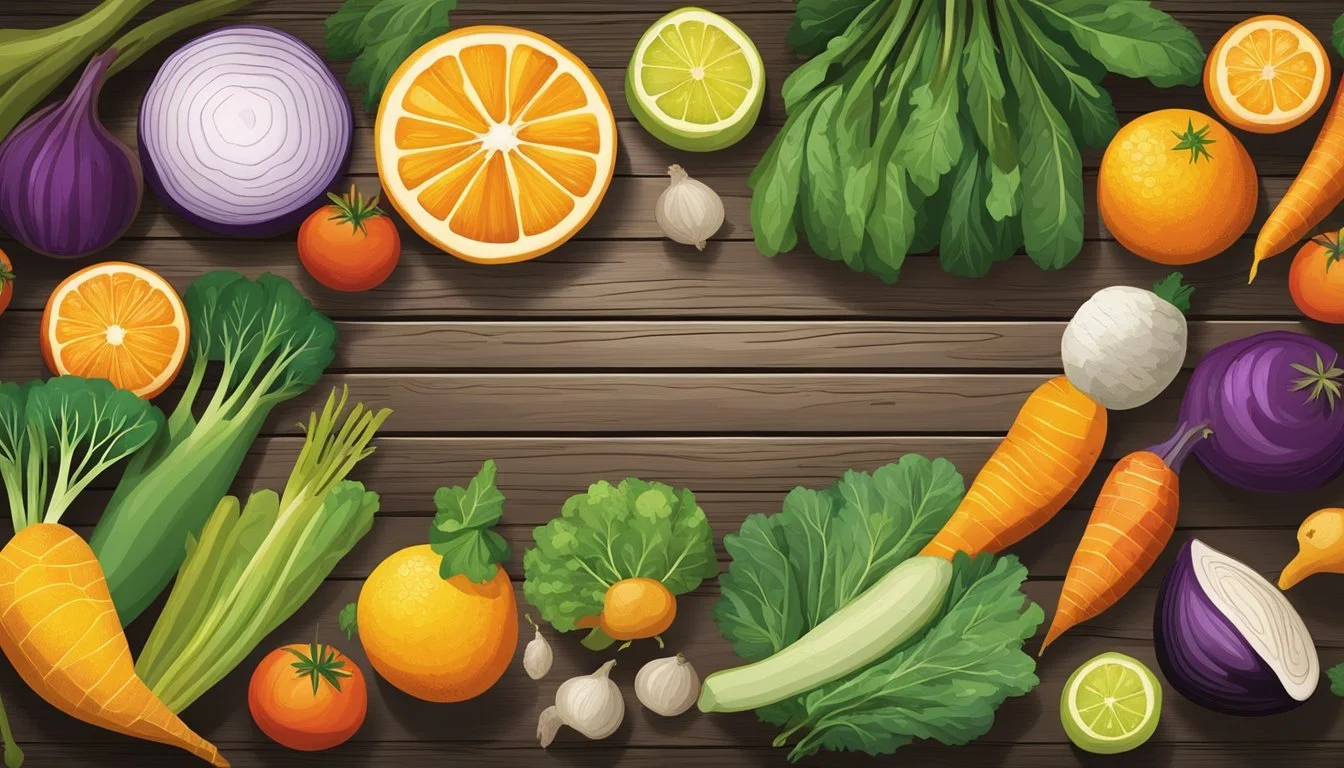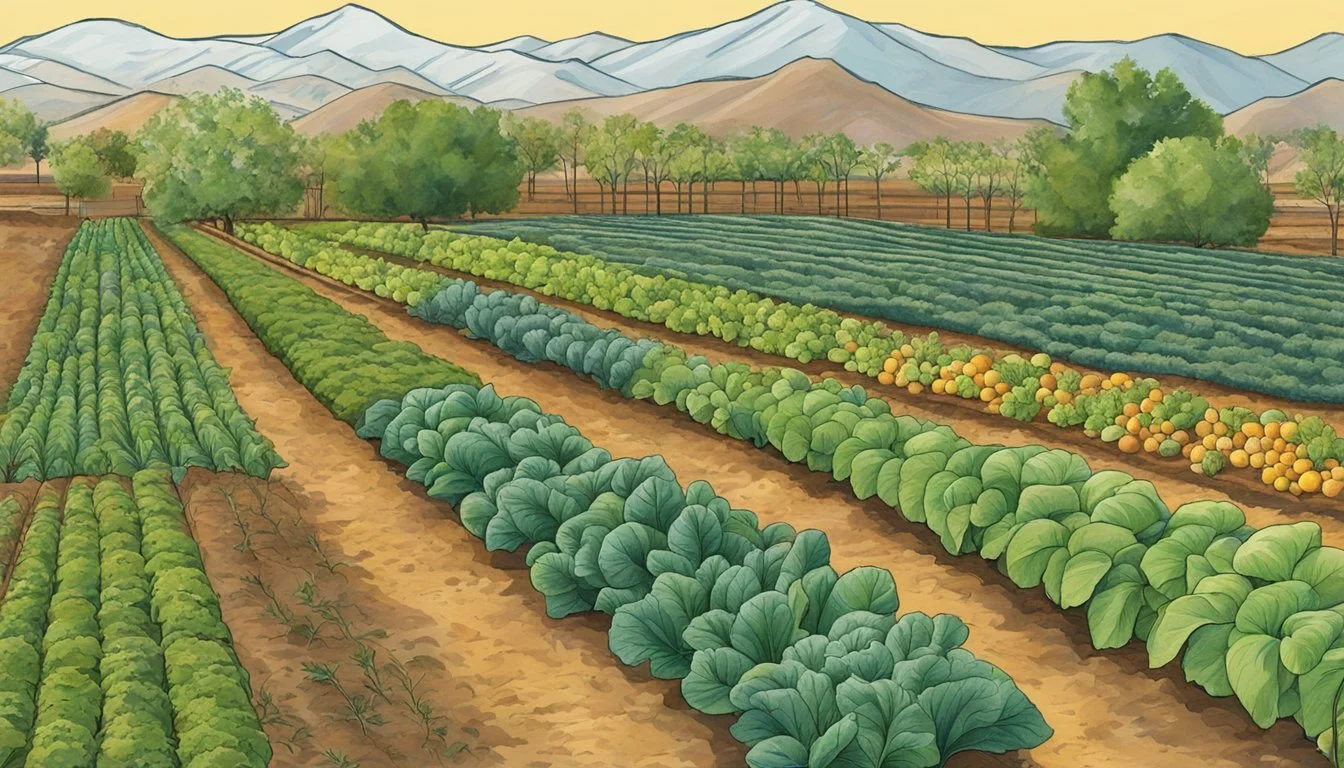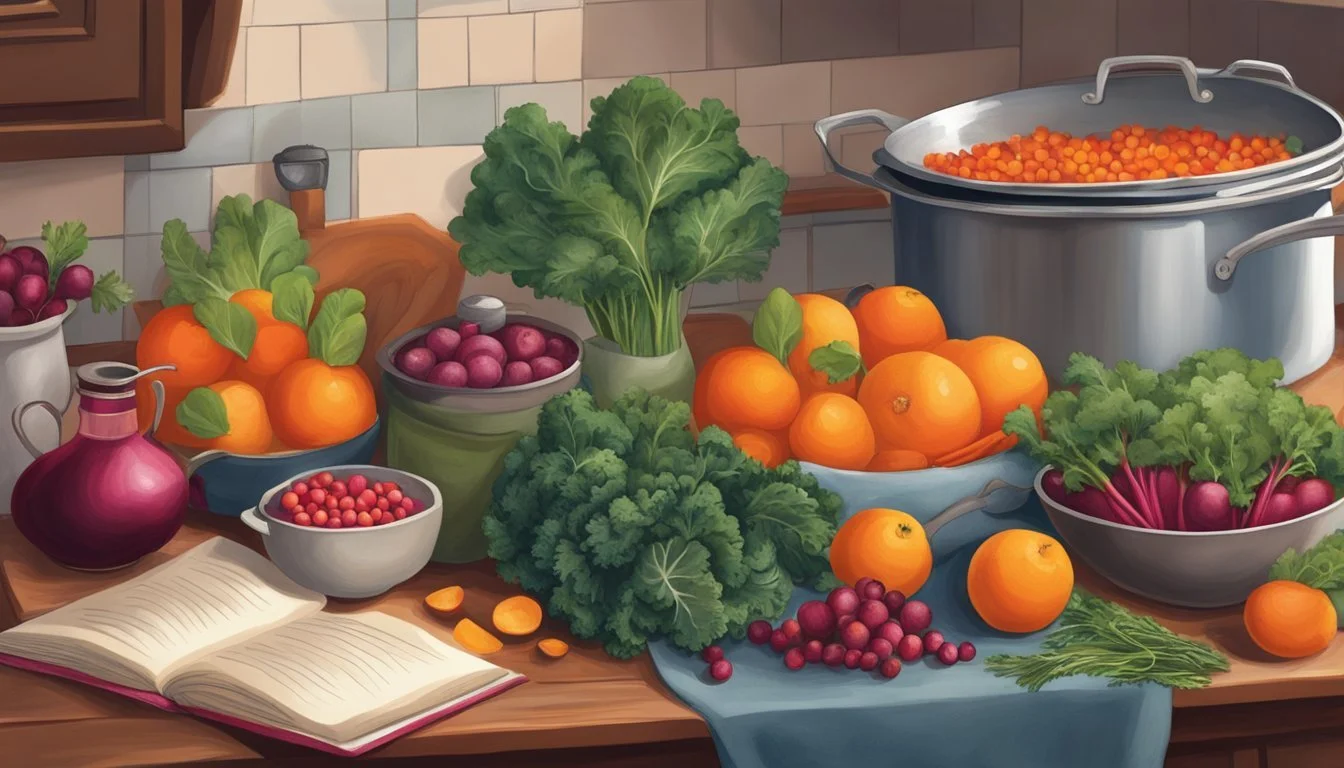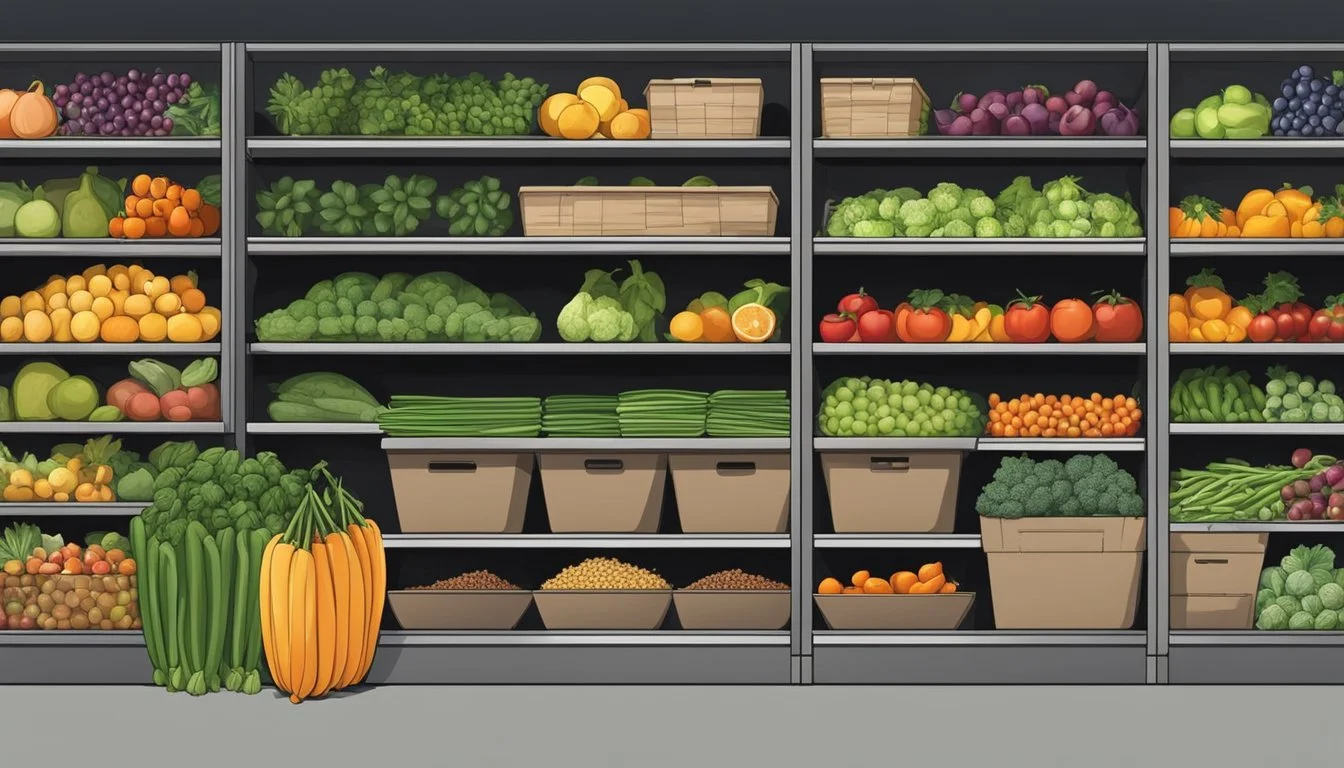Nevada Seasonal Fruit & Vegetables in January
A Guide to Fresh Produce
This Article is Part of our Nevada Seasonal Fruit & Veg Calendar
In January, the chill of winter envelops Nevada, yet the state's produce scene remains robust, offering a variety of fruits and vegetables that can withstand the colder temperatures. The desert climate, characterized by significant temperature shifts from day to night, influences the seasonal availability of produce. While the selection is not as abundant as in the warmer months, January's offerings are characterized by hearty vegetables that are integral to winter comfort dishes.
The seasonal produce palette in Nevada during January is diverse, featuring hearty greens and an array of cruciferous vegetables. Kale, known for its nutritional value, is a staple in winter gardens and on dinner tables. Alongside kale, other members of the cruciferous family, such as broccoli, cauliflower, and the geometrically intriguing romanesco, provide a variety of textures and flavors that are well-suited to cold-weather recipes. These vegetables are not only resilient in cooler climates but are also packed with vitamins that help bolster the immune system during the winter season.
Citrus fruits, with their zesty flavors and high vitamin C content, shine during Nevada's January. The bright tones of oranges and lemons bring a burst of flavor to winter days, pairing well with the earthy notes of the seasonal vegetables. While the fruit selection is less varied than in summer months, these citrus gems stand out for their freshness and ability to enhance both sweet and savory dishes. The availability of such produce ensures that residents and chefs alike can create nutritious meals that echo the vitality of the season.
Overview of Nevada's Seasonal Climate
Nevada's climate in January is characteristic of its winter season, experiencing low temperatures and minimal precipitation, which in turn has a significant influence on agricultural activities.
Understanding Nevada's Winter Weather
Nevada's winter weather is influenced by its geographic location within the Great Basin Desert, leading to cold and dry conditions throughout the season. Temperature averages range considerably across the state with northern regions experiencing colder temperatures compared to the south. Precipitation is sparse during January, with snowfall primarily occurring in the higher elevations of the Sierra Nevada mountains.
Impact on Crop Growth
The cold and arid climate of Nevada during winter places certain constraints on crop growth. Farmers in Nevada are limited to a select group of cold-hardy crops. Hard freezes can be expected, requiring careful selection and cultivation of crops that can withstand such conditions. Daylight hours are also reduced in winter, further impacting the growth cycle of January produce.
Seasonal Fruits Available in January
In Nevada, January calls for a limited, yet distinct selection of fruits that can withstand the chilly weather. The available varieties offer a blend of citrus zest and the subtle sweetness of winter-hardy pome fruits.
Citrus Varieties
January in Nevada sees a variety of citrus fruits reaching their peak. Oranges and grapefruits are notably juicy and rich in vitamin C during this time, offering a fresh burst of flavor and nutrients. Lemons and limes are also abundant, ideal for use in recipes to add a bright, tangy note.
Oranges: Sweet and tangy, perfect for fresh eating or juicing.
Grapefruits: Larger citrus known for its slightly bitter taste, great for a refreshing start to the day.
Lemons: Essential for cooking and baking, delivering a sour punch.
Limes: Smaller than lemons, with a unique zest that complements a wide array of dishes.
Pome and Stone Fruits
Although the selection of pome and stone fruits in January is narrower than in the summer months, consumers can still enjoy certain late-harvested or cold storage varieties of apples and pears. These fruits maintain their crisp texture and sweetness, making them a valuable addition to the winter diet.
Apples: Stored from fall harvest, still crisp and sweet.
Pears: Various types available, ranging from buttery and soft to firm and grainy.
Seasonal Vegetables Available in January
In January, Nevada's local markets have a bounty of robust root vegetables and vibrant leafy greens that are at their peak. These vegetables are not only flavorful but also packed with nutrients, perfect for winter meals.
Root Vegetables and Tubers
Nevada's January soils yield a rich harvest of root vegetables and tubers. This category includes vegetables such as:
Carrots (how long do carrots last?): Prized for their sweetness and texture, carrots are versatile in the kitchen, whether eaten raw or cooked.
Turnips: Often overlooked, turnips have a slightly peppery taste and can be used in a variety of dishes from roasts to stews.
These vegetables store well and can add substantial heartiness to winter dishes.
Leafy Greens and Cruciferous Vegetables
The cooler weather encourages the growth of certain leafy greens and cruciferous vegetables. Notably available in January are:
Kale: A nutritious staple, kale is available fresh in January and can be used in everything from salads to soups.
Cabbage: Another hearty option, cabbage offers a crunch in salads and slaws but also stands up well to braising and stewing.
These greens are known for their health benefits, including high vitamin content and fiber.
Health Benefits of Seasonal Produce
Eating seasonal fruits and vegetables from Nevada provides optimal nutrition and flavor. It harnesses the peak of a produce's natural ripeness and nutrient content.
Nutritional Advantages of Winter Produce
Fruits such as oranges and lemons are plentiful in Nevada during January. They are high in Vitamin C, which is essential for immune system function, especially during the colder months. Vegetables available in the season, like kale and other cruciferous vegetables such as broccoli and cauliflower, are rich in vitamins A, C, and K. They also contain fiber, important for digestive health, and antioxidants that may reduce the risk of certain diseases.
Vitamin C: Supports immune health and skin integrity
Vitamins A & K: Essential for vision and bone health, respectively
Fiber: Aids in digestion and may help control blood sugar levels
Cooking with Fresh Seasonal Ingredients
Cooking with fresh, seasonal ingredients not only enhances the flavor of food but also maximizes the health benefits. Creating recipes with January's produce like citrus fruits can add a refreshing zest and boost vitamin content in meals. Incorporating dark, leafy greens can increase iron and calcium levels. Seasonal cooking promotes the use of ingredients at their peak, which means fewer additives are needed to achieve desired flavors, leading to cleaner, healthier dishes.
Citrus fruits: Introduce a burst of flavor and vitamin C
Dark greens: Offer dark leafy greens that boost iron and calcium in dishes
Growing Your Own Food in Nevada
In Nevada, growing your own food can be a rewarding endeavor, taking into account the unique climate and soil conditions. Gardeners should be well-equipped with the knowledge of how to adjust their practices in the face of the state's varied temperatures and desert landscape.
Winter Gardening Tips
In Nevada's winter, temperatures can vary widely, but with the right strategies, a garden can thrive. One should prioritize soil preparation by integrating organic matter to improve water retention and provide necessary nutrients. Mulching is also important to protect roots from sudden temperature drops. Gardeners should consider cold frames or greenhouse structures to extend the growing season, as well as select vegetable varieties that are frost tolerant.
Selecting the Right Crops for Your Garden
Selecting the appropriate crops for January planting in Nevada hinges on understanding the hardiness and growth cycle of each vegetable. Radishes are a good choice as they don't require much space and have a quick growth cycle. Root crops generally do well in cooler temperatures. Here's a concise list of suitable vegetables to grow in Nevada during January:
Radishes: Plant with ample spacing for optimal growth.
Cabbage: Cold hardy and suitable for Nevada winters.
When choosing crops, gardeners should also be aware of the specific zone they are in, since Nevada includes USDA zones 5 through 9, affecting what plants are suitable for their local climate conditions.
Buying Seasonal Produce
Shopping for local and seasonal produce in January provides an opportunity to support Nevada's farming community and enjoy the freshest flavors available.
Farmers Markets and Local Sources
Nevada's farmers markets offer a diverse array of fresh produce even in the winter months. They are vital for consumers looking to purchase seasonal vegetables such as hearty kale and various citrus fruits that can boost the immune system. Shoppers can find markets open in January, though they may operate with reduced hours or on a bi-weekly schedule. The following are some examples of fresh produce typically available at Nevada farmers markets in January:
Vegetables: Kale, spinach, leeks, radishes
Fruits: Citrus varieties (such as oranges and lemons)
One should always verify the operational hours and locations of local farmers markets before visiting, as these can change depending on the season.
Identifying and Selecting Ripe Produce
Selecting ripe produce ensures the best taste and nutritional value of the food consumed. Here are some signs of ripeness for January's seasonal produce:
Kale: Look for richly colored, dark green leaves. Leaves should be firm and fresh-looking without any yellow spots.
Citrus Fruits: Choose fruits that are heavy for their size, indicating juiciness. They should have vibrant, unblemished rinds.
Tip: When in doubt, one can always ask the vendor for advice on selecting the best produce, as they are generally knowledgeable about the ripeness and taste of their offerings.
Recipes and Preparation Ideas
In January, Nevada’s seasonal produce paves the way for warm, comforting dishes as well as light, nutritious snacks. These recipes are crafted to maximize the flavors and nutritional benefits of what's freshly available.
Winter Comfort Foods
Hearty stews and casseroles are quintessential in January for utilizing Nevada’s seasonal vegetables. Root vegetables such as carrots and turnips, which are often at their best during the colder months, make for robust and flavorsome bases in such dishes. One might consider a slow-cooked beef stew, (What wine goes well with beef stew?) incorporating these vegetables with a blend of warm spices like cinnamon, allspice, and cloves (how long do cloves last?) for an unexpectedly savory twist. For a vegetarian option, a Brussels sprouts (how long do brussels sprouts last?)gratin utilizes local produce to create a creamy and satisfying side dish or main course.
Sample Recipe: Slow-Cooker Braised Beef with Carrots & Turnips
Prep Time: 20 minutes
Cook Time: 8 hours
Ingredients:
2 lbs beef chuck roast
4 carrots, peeled and chopped
3 turnips, peeled and chopped
1 tsp cinnamon
½ tsp allspice
¼ tsp cloves
Salt and pepper to taste
Instructions:
Season the beef with salt, pepper, and spices.
Place the beef, carrots, and turnips in the slow cooker.
Cook on low for 8 hours until the meat is tender.
Healthy and Refreshing Snacks
Salads and quick bites that highlight fresh citrus and crisp greens are ideal for after-holiday cleansing. A salad featuring kale, Brussels sprouts, or cabbage provides a wholesome and refreshing option. Using fruits like pomegranates, which are also in season, can offer a juicy burst of flavor and a wealth of antioxidants. Pomegranate seeds (how long do pomegranate seeds last?) can be sprinkled over a shaved Brussels sprouts salad, pairing well with a simple lemon vinaigrette.
Pomegranate and Shaved Brussels Sprouts Salad
Dressing:
3 tbsp olive oil
1 tbsp fresh lemon juice
1 tsp honey
Salt and pepper to taste
Salad:
1 lb Brussels sprouts, trimmed and shaved
1 pomegranate, seeds removed
1/4 cup sliced almonds (optional)
Instructions:
Whisk together the dressing ingredients.
Toss the shaved Brussels sprouts and pomegranate seeds in the dressing.
Top with almonds for added crunch if desired.
Preservation and Storage of Produce
In Nevada, January's cooler temperatures necessitate proper preservation and storage methods to extend the shelf-life of seasonal produce. These methods help maintain food quality and minimize waste.
Canning and Preserving
Canning is an effective method for preserving fruits and vegetables, including January produce like lemons and limes. High-acid foods such as these can be processed using a water bath canner, while low-acid items require a pressure canner to prevent the risk of foodborne illness.
Steps for Water Bath Canning:
Prepare - Wash and chop produce; sterilize jars and lids.
Fill - Pack jars with produce and cover with syrup, juice, or water.
Seal - Apply lids and tighten the bands to fingertip tightness.
Process - Place jars in the canner, cover with water, and boil for the recommended time.
Cool - Remove jars and let cool for 12-24 hours. Check seals before storage.
Steps for Pressure Canning:
Prepare and Fill - Similar to water bath canning, but use only pressure canner approved recipes.
Vent - Allow steam to vent for 10 minutes before adding the weight.
Process - Adjust pressure according to altitude and process for the recommended time.
Cool - Let the canner depressurize on its own, then cool jars as above.
Optimal Storage Conditions
Storing produce at the proper temperature and humidity is key to longevity. Each type of produce requires specific conditions:
Table: Storage Conditions for Nevada Produce in January
Produce Temperature Humidity Storage Location Lemons 32°F - 40°F (~0°C) 85%-90% Refrigerator crisper Limes 32°F - 40°F (~0°C) 85%-90% Refrigerator crisper Dark greens 32°F - 36°F (~0°C) 95%-100% Refrigerator, in airtight containers Root vegetables* just above freezing 90%-95% Cool, dark, well-ventilated area
*Root vegetables include beets, carrots, and potatoes.
Producers should avoid storing fruits and vegetables together when possible, as fruits can release ethylene gas which can accelerate ripening and deterioration in vegetables.
Nevada's Seasonal Produce Calendar
Nevada's harvest calendar provides a clear, month-by-month breakdown of when fruits and vegetables are typically at their peak. Consumers looking to enjoy the freshest produce can find it beneficial to understand what's available throughout the year.
Month-by-Month Guide for Fruits
January in Nevada sees a limited selection of local fruits due to the colder weather. However, storage apples are often still available from the previous fall's harvest and offer a crisp, fresh taste even in the winter months.
Month-by-Month Guide for Vegetables
For vegetables, January offers a more diverse array within Nevada's seasonal calendar. Consumers can find a variety of hearty vegetables, including:
Carrots: They remain crisp and sweet, often stored successfully from fall.
Cabbage: Known for its cold resistance, cabbage is typically harvested into the winter.
Brussels sprouts: They thrive in cooler temperatures and are generally ready for harvest.
Garlic: Stored from prior months, garlic continues to be a staple in winter cuisine.
Looking forward to the end of the year, from November to December, the seasonal produce remains similar to January, with root vegetables and winter greens taking center stage. Consumers can take advantage of the lasting harvest that often includes pumpkins and squashes from the earlier fall months.









